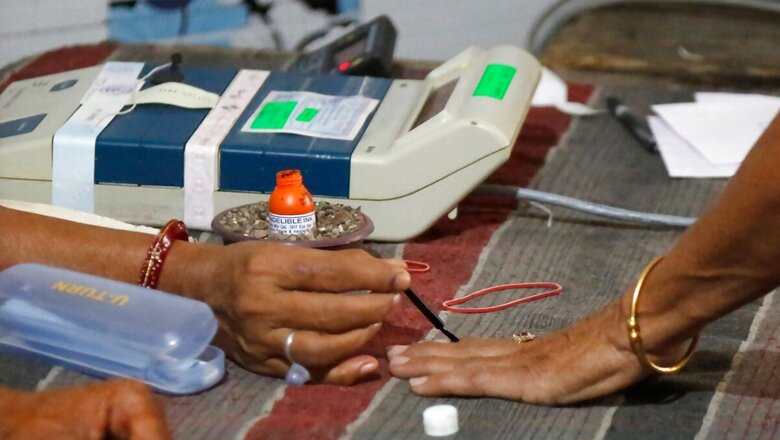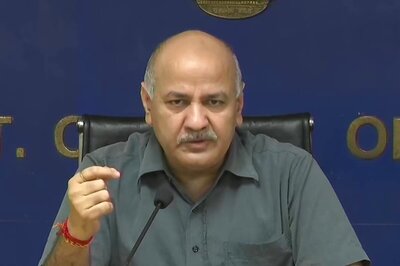
views
The Jaipur Rural Lok Sabha constituency in Rajasthan comprises eight assembly segments: Kotputli, Viratnagar, Jhotwara, Jamwa Ramgarh, and Bansur (all represented by the BJP), and Shahpura, Phulera, and Amber (all represented by the Congress).
The key candidates for the Lok Sabha polls this time are the Bharatiya Janata Party’s Rao Rajendra Singh and Anil Chopra from the Congress.
The seat will see polling on April 19, in the first round of the seven-phase Lok Sabha elections.
Electoral Overview
Jats and Gurjars constitute a large section of the electorate in Jaipur Rural. Yadavs or the Ahir community also exist in large numbers in Kotputli, Shahpura, Bansur, Jhotwara, Viratnagar, and Amber, and have a significant presence in Phulera and Jamwa Ramgarh, with a population of over 3 lakhs. Brahmins and Rajputs too have sizable populations in the constituency.
In the 2019 general elections, Jaipur Rural witnessed a fierce contest, with a 65% voter turnout. BJP candidate Col Rajyavardhan Rathore won by a margin of 3.93 lakh votes, defeating the Congress’s Krishna Poonia.
Current Dynamics
- The BJP this time is betting on Rao Rajendra Singh, who was a member of the Rajasthan legislative assembly from Shahpura for the party between 2003 and 2018. He was also deputy speaker in the Vidhan Sabha earlier. He lost the assembly polls in 2018 and was not given a ticket in the 2023 elections. Rajyavardhan Singh Rathore has not been renominated as he now represents the Jhotwara assembly constituency. Several names were being considered by the BJP for this seat. The announcement of Rao Rajendra Singh’s candidature came as a surprise to many, though he is a well-known face who shot to fame after defeating then deputy chief minister Dr Kamla Beniwal in the 2003 assembly elections.
- Interestingly, ex-Congress leader Lalchand Kataria was considered by many to be the strongest BJP contender for the Jaipur Rural Lok Sabha seat. Kataria was among several Congress leaders who joined the BJP in early March. He was the MP from Jaipur Rural between 2009 and 2014. The name of retired army officer Priyanka Chaudhary was also discussed for the seat. As the constituency has an influential Rajput voter base, many leaders from the community were also vying for the ticket.
- Ground inputs suggest that the BJP is the only party with a visible campaign in the run-up to the elections. There is a genuine Modi wave working to the party’s advantage, and people continue to trust the Prime Minister to deliver on his promises, said observers. The youth, however, appear to be getting disillusioned owing to a variety of factors ranging from the Agnipath scheme to a lack of sufficient employment and livelihood opportunities in the region.
- The BJP remains in a strong position in and around Jaipur. From just two seats out of the ten in Jaipur Rural in the 2018 assembly polls to six last year, it has been a significant recovery for the party. BJP’s victory in six assembly constituencies in Jaipur Rural becomes particularly significant when seen in the light of how two Congress bigwigs left no stone unturned in taking credit for their roles in establishing the new districts of Dudu and Kotputli but failed to capitalise on this in the elections.
- With new leaders coming to the forefront of the state BJP, the ticket distribution indicates that a power shift has taken place. The party has so far tried to balance caste equations in the state while distributing seats, giving tickets to seven Jats, four Rajputs, two Brahmins, two OBCs, a Vaishya, and a Gurjar. However, analysts said caste factors generally favour the Congress. If voters revert to voting on the basis of their communities, the BJP could face a major upset in the state, they said. There are no clear indications though of any such trend right now, they said, adding that the Modi factor continues to dominate the electoral discourse in Jaipur Rural.
- The Congress does not appear to have recovered from the staggering loss it faced last December in the assembly polls, which saw the BJP storming back to power. The party has fielded a new face, Anil Chopra from Jaipur Rural. Chopra was the president of the Rajasthan University Union in 2014-15 and also held the post of national secretary, NSUI — the student wing of the Congress. Chopra is said to be a close associate of former deputy chief minister Sachin Pilot.
- Anil Chopra is seen as a youth face in Rajasthan politics. The politician during his tenure as president of the Rajasthan University’s student union encouraged many students to pursue sports and academics. As a part of the university’s manifesto, Chopra had initiated a drive for students to open zero-balance savings accounts in banks. The Jaipur Gramin Lok Sabha Cricket Mahakumbh 2019 was a successful sports event organised by the politician for aspiring sportsmen from the Jaipur Rural constituency. Evidently, Chopra has been preparing to get a Congress nomination for years.
- Ground inputs suggest that if Sachin Pilot and Anil Chopra can together get their messaging right and become more visible among the public, they could pose a significant challenge to the BJP. With lakhs of voters belonging to the Gurjar, Jat and Yadav communities, the Congress is sitting on a favourable caste topography but is failing to capitalise on it.
- In the assembly elections last year, loyalists and aides of both former chief minister Ashok Gehlot and senior leader Sachin Pilot had to face defeat. Gehlot’s advisor and former minister Babu Lal Nagar, who played a pivotal role in creating Dudu as a separate district, was the first candidate to face defeat during the counting of votes. Similarly, in a surprising turn of events, Congress candidate and minister Rajendra Singh Yadav lost in the Kotputli constituency to BJP’s Hansraj Patel. Ved Prakash Solanki, a Sachin Pilot loyalist who had secured the Chaksu seat for Congress in the past, suffered a defeat at the hands of the BJP last December. This shows that the Congress’ position is not as strong as it used to be, say observers. In a national election where PM Modi is practically on all the BJP’s ballots, the Congress faces a significant challenge in getting voters in Rajasthan to favour it. Importantly, the BJP registered clean sweeps in Rajasthan both in the 2014 and 2019 Lok Sabha elections.
- The Congress has also been rocked by a rampant exodus of leaders to the BJP, in what should be a tell-tale sign of which way the political winds are blowing. On March 10, over two dozen leaders in Rajasthan, chiefly from the Congress, joined the BJP, giving a jolt to the grand old party ahead of the Lok Sabha elections. Officially, the BJP said 1,370 people took its membership on the day. The Congress, though, is hopeful that its alliance with the Rashtriya Loktantrik Party (RLP) will pay sufficient political dividends in Rajasthan this time. The Congress-RLP alliance could make the fight tougher for the BJP on seats where Jats constitute a significant voting bloc while also potentially impacting seats like Jaipur Rural. However, ground reports do not suggest that the alliance is posing a significant challenge to the BJP in Jaipur Rural yet.
Key Issues
- The town of Kotputli has been facing water-related issues as some areas were submerged for the past year under sewerage water. The residents are frustrated with the dirty and unhygienic conditions, which have led to waterborne diseases. However, reporters on the ground say this may not become a crucial election issue across the constituency that could turn the results for or against a party. They contend that the people of Rajasthan have learnt to live with water scarcity.
- In the Jat belt, largely spreading from Barmer in western Rajasthan to Sri Ganganagar in the north, through Nagaur district and the Shekhawati region, the issues of minimum support price (MSP) for crops, remunerative prices for agricultural produce, electoral bonds, Agni[ath scheme, and the recent wrestlers’ protest have started dominating the public discourse. The Agnipath military recruitment scheme is a particularly contentious topic in Rajasthan, especially in rural areas from where the youth was always eager to join the armed forces. The sentiment is largely against the scheme in Rajasthan.
- Ground inputs suggest that the people are not particularly seething with anger against either the central or the state governments. While minor inconveniences persist, the larger view of the Modi government being good for the state and the country continues to prevail.
- Jaipur Rural does not appear to have a significant livelihood crisis. People are primarily earning a living mostly from agriculture and being involved in the trucking industry.
- The BJP’s Hindutva push continues to be a major issue. With the implementation of the Citizenship Amendment Act, construction and inauguration of the Ayodhya Ram Mandir and PM Modi setting a symbolic goal of “Ab ki baar 400 paar”, BJP’s image of being a nationalist party that prioritises Sanatan culture has been reinforced.
- Prime Minister Modi’s welfare schemes meant for the delivery of basic amenities like houses, tap water, toilets, LPG, and electricity connections continue to be appreciated by the people. The PM Kisaan Samman Nidhi Yojana and direct cash transfers to farmers have also helped the BJP court favour among voters.
Voter Demographics (approx)
- Total Population: 19,33,331
- Urban Voters: 301,600 (15.6%)
- Rural Voters: 1,631,731 (84.4%)
- SC Population: 303,533 (15.7%)
- ST Population: 168,200 (8.7%)
- Muslims: 60,000 (3.1%)
Key Project
The Ambala-Kotputli corridor has been developed at a cost of approximately Rs 9,500 crore, signifying a substantial investment in the infrastructure development of the region. The project is part of the Bharatmala Pariyojana Phase-I programme.
The corridor is designed to offer the shortest, fastest, and safest route from Ambala to Kotputli along the Jaipur highway.


















Comments
0 comment